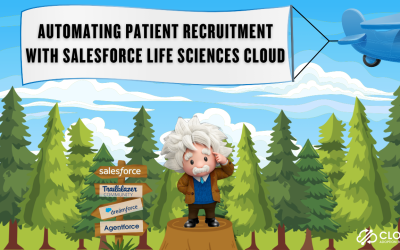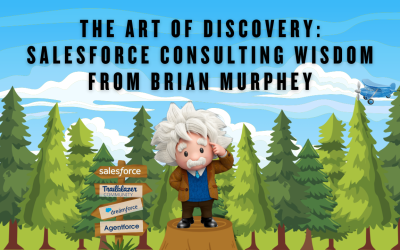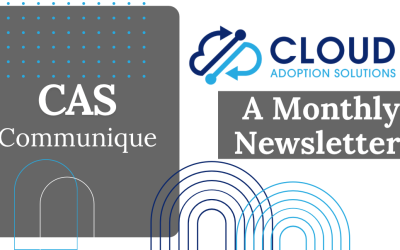Scary Things in Client Salesforce Orgs: CAS Chats Video
Salesforce developers and admins may seem like the strong and silent types – but when you can get them to open up about their favorite topics, they have fun things to share! Join Jarret and Lucas as they chat casually from the CAS Summer Summit about Scary Things in Client Salesforce Orgs.
Contact us with your Salesforce challenges at info@cloudadoption.solutions – we love to help!
Cloud Adoption Solutions is a 100% woman-owned registered Salesforce partner, specializing in implementation, integration, and optimization for Technology, Healthcare/ Life Sciences, and Financial Services/ Professional Services organizations in the small and mid-commercial sectors.
VIDEO TRANSCRIPT:
Speaker 0:15
Hi, Jarret, hello, Luke. Today we’re just gonna talk about a few ugly things we see when we get into a new Salesforce org. So we’re cloud adoption solutions where Salesforce partners, and we see a lot of Salesforce orgs. So we’re just going to review a few ugly things we see when we get in there. Just a few, just a few. So first topic we’re going to talk about is clients not using the lead object. Now, what considerations fall out from this, Jarret? First of all, please use the lead object. When you start with accounts and contacts, you’re going to be inserting way more data, you’re not going to be able to use the lead process right out of the gate. There’s, there’s several other things. Yeah. So it’s harder to just put in just contacts because they need a parent, right? They need an account, parent account. And so also lead, there’s many tools that connect to Salesforce don’t use delete objects. And so it’s easier to use those tools. Another topic, or consideration I can think of is reporting, do you want to see that whole sales lifecycle, you’re not going to see a conversion from using a contact, you see a conversion from a lead and turns into three objects, right? So yeah, much better practice to use lead.
Speaker 1:55
The lead status is already there. If you go in with contacts and accounts, you’re gonna have to build that on your own.
Speaker 2:02
Cool, great. Let’s talk about another topic, a lot of things we see is we see some old code, right, on old API versions. And also, with this old code, a lot of times there’s not even a unit test with it. Right. So talk about that. Yeah, maybe the maybe or it’s been around for, you know, a decade. And you had code deployed in 2012 2013. That’s on API version. 19, maybe, yeah, something I had one. Yeah. And you did need a unit unit test back then. You’re gonna need one soon. real soon, yeah, certain things that you might want to deploy to your work will need to run all your unit tests, and those ones are going to fail, because there is no new test for them. Right. And then working along with that topic. With unit tests, a lot of times we see badly written unit tests, where they’ll just do an i plus plus method, and call that method from their unit tests.
Speaker 3:14
Yeah. So you’ll see how it’s about down here.
Speaker 3:17
Yeah, people will, they’ll make the shortcut just to get the code coverage and not cover any other functionality in their tests. So you might see, you know, 750 lines of an increment, just, you know, just get that 75% of code coverage.
Speaker 3:35
So I was gonna ask that that’s the minimum code coverage for unit tests. Right, right up to 75%. Yeah, so that’s just a work around hack your unit tests should perform, and actually test your code to make sure it’s always working. You know, you should have a good test and a bad test with each unit test to test for null negatives, right in bulk. While test doc test is good in Salesforce, you know, we can run bulk data loads, and bulk updates. Yeah, the tests will take longer to write than the code. Pretty much. Cool. Well, that’s good for that topic. And then we got one more topic to talk about. I’m sure a lot of people see this one is, every user in the org has a system admin profile. Let’s talk about that. Yeah, don’t do that. Don’t do that. That means everyone in the org has the keys to the castle. And everyone can do make modifications to your, you know, your back end settings, your metadata settings. And there’s no considerations where you don’t know what anyone could do at any time.
Speaker 4:41
Just like a sales user doesn’t need that access to most of Salesforce. Really? Yeah.
Speaker 4:48
I mean, then on the next set of menu, yeah. Now, especially now with lightning. Everything’s in the front end. Yep. On the user side. So don’t do that. They do not need that. Hire an admin. That’s tricky. All right. Well, those are good topics. Thanks, great discussion, Luke. Yeah, that’s all we have time for today. Remember, we are Cloud Adoption Solutions, Salesforce partners. You can reach out to us with any questions.
SUMMARY KEYWORDS:
Salesforce, Lead Object, Old Code, Old API, API Version, Salesforce Developer, Salesforce Developers, Salesforce, Salesforce.com, SFDC




